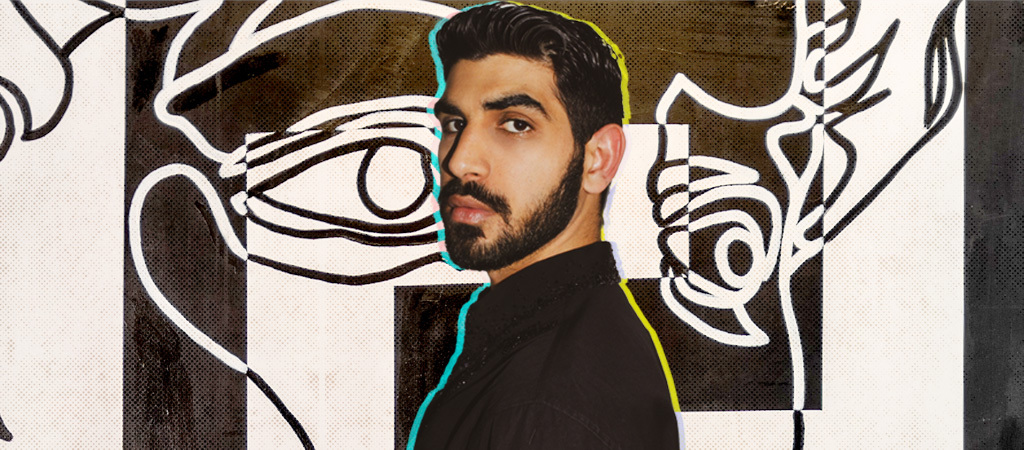Bilal Rehman didn’t plan to be an interior design mogul, at least not initially. At just 24, the Houston-based studio owner has become the face of a younger, more approachable, and imaginative interior design industry, but a few years ago his career ambitions included titles like “doctor, engineer, and lawyer” he tells UPROXX.
“I ended up choosing computer engineering as my major,” he says. “I started doing that and was like ‘Oh, this is not what I want to do with my life!’” He switched his major to business and when it came time to choose an internship he focused on a field that had always held his fascination. “I got an [interior design] internship and loved every second of it and climbed my way up to senior level designer until I decided to leave just over a year ago and launch my own studio.”
That leap to running his own studio was a success, with Rehman celebrating a multi-million-dollar first year. Next on his list, now that he’s transformed his gallery to include items you can purchase for your home, is releasing the multiple product lines he’s been working on and moving forward with his dream of publishing a book. But the most compelling part of Rehman’s story? Not that he found success in a field known for its inaccessible luxury, but that he used social media to grow his business and spread his design know-how, making his advice available to anyone.
Rehman’s witty TikTok videos (like the aptly titled “Three Things That Are Making Your House Look Cheap As F*ck”) hilariously offer attainable design advice that anyone can incorporate into their home regardless of the state of their bank account. Those videos have amassed millions of views (and counting) and now, Rehman is using his sharp sense of humor and innate knack for aesthetics to transform what he calls a “very snobby industry.”
Below, Rehman talks to UPROXX about why his social media approach differs from other designers, why you should “run your dream” like a business, and the inspirational impact his gallery and studio have had so far.
What was the moment you decided to start your own gallery and studio? What inspired that decision?
I’m in Houston and we’re in the middle. So we don’t have that cool LA and we don’t have the sophisticated New York. Everything is huge here because the houses have 22-foot ceilings and they all look the same. The style here is very one-track-minded. I found myself, um, butting heads a lot with my previous studio because everybody there was designing one way and I was designing in a completely different way. A lot of times they would shoot down my ideas or my designs would never come to fruition because the creative director there would end up changing it all to look like a Pottery Barn catalog. So I was like, ‘You know what? Fuck this. I’m gonna go ahead and start my own studio and bring a new flavor of design to Houston. Why not?’ And so I did it and it’s proven to be successful. People here are now really loving it. I see more and more people changing their styles and more and more people adopting black into their interiors, which I’m loving.
Enough cream everybody!
Yes. No more cream, no more sea foam blue! That ship has sailed. So now people are getting more adventurous with their styles and ideas.
Let’s talk about leveraging social media to create an audience. There’s so much information out there about how you can reach an audience and what you should do. How did you grow and reach an audience successfully?
The big thing I realized was that I’m young. I have this tool in my toolbox for understanding the next generation. I understand what people my age and a little younger than me want. For the most part, it’s a very snobby industry. It’s full of people who think that they’re better than you. It’s full of people who want to be this big household name and think that their designs are the best in the world. A lot of times when they’re trying to market themselves or when they’re trying to do social media, they put on that show, they put on the snob show. They put on the ‘I’m ultra-wealthy and I have expensive taste and expensive clients.’
It doesn’t resonate with our generation. Our generation doesn’t give a shit about that. We don’t care that you have a Black American Express card and that you’re doing a house that’s $5 million. That to us is not impressive. With my social media, I made it less about the snob factor and more about how can you bring a luxurious flavor and a luxurious spin to your interior no matter your budget, whether you’re shopping at IKEA or you’re shopping at an ultra-expensive store. Like, ‘Here is your recipe on how to fix your space and get rid of all the ugly that you’ve done and replace it with the good stuff.’ I think what really stuck with the audience is that I wasn’t trying to be inauthentic, I wasn’t trying to put on a show. I was really just telling you from an actual interior designer, here are the tips and tricks of the industry that nobody else is gonna tell you unless you pay them a hundred thousand dollars.
Have you spoken to any followers that have taken your advice and what are some of the reactions and successes they’ve shared?
There was a kid here in Houston who came to the gallery and I happened to be here and he totally fangirled when he saw me and was freaking out and wanted to take a picture. He told me that I had inspired him to look into the world of interior design and now he wants to be an interior designer when he grows up. That was huge, inspiring other people to be creative and I love it. The other one was really wild… there was this wife and husband who had just bought this house and I guess they had been butting heads on the entire process. Going through the renovation had put a wedge in their relationship, and they were on different [ends of the] spectrum, and money was involved. They ended up getting a divorce. She messaged me and was like ‘Because of your tips and tricks I finally found the strength to tell my husband to fuck off’ [laughs] and I was like ‘Oh my God.’
So, she has the house she wants now.
Literally. The other one was a doctor. I think she was in Atlanta and she had been a doctor for maybe 14 or 15 years. She had always wanted to do something creative, but she never got the push. She came across my page and saw my videos and then she ended up closing her practice and starting an interior design practice. She’s been incredibly successful. She says she would never turn back and go back into the medical profession. So you know, it’s really heartwarming to see how something I didn’t think was going to have such a strong impact on people has really changed their lives, whether it’s from a divorce or changing your career.
I also want to talk about finances, specifically around how you said you were going to choose careers you assumed would be lucrative but ended up going the creative route and still being successful. I’m curious, what advice would you offer to people when it comes to managing their finances with their dreams?
I think the biggest mistake most people make when they’re trying to pursue a dream is that they don’t look at their dream as a business. They look at it as this amazing, magical thing, which it is to some extent, but at the end of the day, we all have to make money. They start treating it like, ‘Oh, it’s okay if I spend this much, or it’s okay if I don’t spend here, or I don’t need to promote here, or I don’t need to spend in marketing, or I don’t need to hire because I can do everything myself.’ Those ideas set people up for failure and that’s why most people are not successful when they’re starting their dreams. For me, being a 24-year-old, not having a design degree, but having the experience, I came into this knowing I had a very clear vision of what I wanted and I self-funded my company just with my savings.
I didn’t take out a loan or anything to start my company. So I was very, very tight on money when I first started. I think I started the company with $30,000 and that was it, the money I had saved over the past eight years of working. I was extremely tight with my budget and it’s so funny because I’m now sitting in my conference room, which just got completed last week, but uh, prior to this I had curtains up creating a division for a conference room. Going into the business world, you have to be very strategic in how you’re spending the money. Up until this point, I’ve been really tight. I’ve been watching every dollar, I’ve been doing a lot of research using social media because it’s essentially free. I think starting a new business and going after your dream, if you are not somebody who just has millions of dollars in the bank you [still] have to be very mindful of not looking at it just as a dream, but also looking at it from a business standpoint of ‘If I spend this money, what is my return going to be on this? Is it worth me doing right now? Or should I hold off for six months until I have more money in the bank and then I can do it and be more comfortable?’ Those decisions are things that a lot of people tend to skip when starting a dream.







